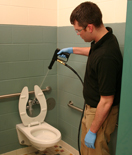| |
 |
|
Amasht Hygiene E-news | November 2012 |
|
| |
|
|
| Public Restroom-A high risk environment |
|
| |
 |
|
From an environmental health scientist’s point of view, a restroom, in particular a public restroom is a high risk environment. That’s because, at its most basic level, the restroom is essentially a bio-hazardous waste transfer station.
Unfortunately, with humans and mechanical systems involved, the transfer is not always as effective and sanitary. Hands get contaminated which then come into contact with flush and sink handles, door knobs, tissue and soap dispensers and other touch points, creating a high risk of faecal-oral transfer and disease. Every flush of the commode creates an aerosol of urine and faecal toxins, releasing millions of waste particles and microorganisms into the air that eventually settle on floors, dispensers and other surfaces. |
|
| |
|
|
These waste substances can be rich food sources for odour and disease causing bacteria, especially in a warm and moist environment. If you listen to a number of critics today, schools and other public facilities are experiencing an undeniable restroom crisis, which can often be avoidable by proper cleaning methods.
Cleaning workers, often unaware of the dangers of cross contamination, re-use their mops and buckets elsewhere in the building, essentially cleaning the hallways with sewage. Cleaning not for appearance but for health must be the ultimate goal.
Designed from the beginning to remove the maximum amount of undesirable soils, bacteria and other indoor pollutants, a no-touch cleaning system combines automatic chemical metering and injection, an indoor pressure washer, and a powerful wet vacuum into a single integrated system. The no-touch cleaning process also enforces the use of fresh ingredients in order to minimize the risk of cross-contamination. Regardless of which method is used in the restroom cleaning process, it is vitally important that results be measured. |
|
 |
|
|
|
 |
 |
 |
| |
The average person falls asleep in 7 minutes.
Dead cells in the body ultimately go to the kidneys for excretion.
The average life span of a single red blood cell is 120 days. |
|
|
|
|
If you don′t want to receive this newsletter, please click on ′unsubscribe′
Amasht Paper Hygiene Products Pvt. Ltd., S.No.23, Thergaon, Pune 411033. email: amasht@vsnl.com www.amasht.com
Please click here if you can′t view the newsletter properly. |
|
|
|
|
|
